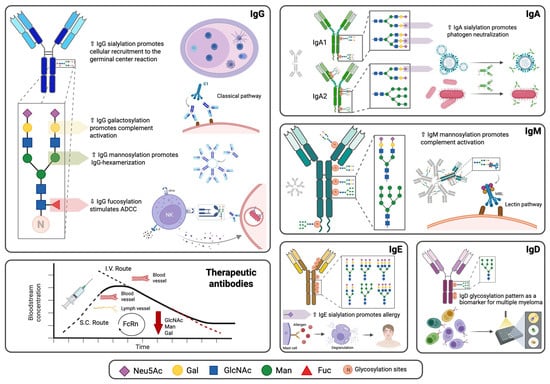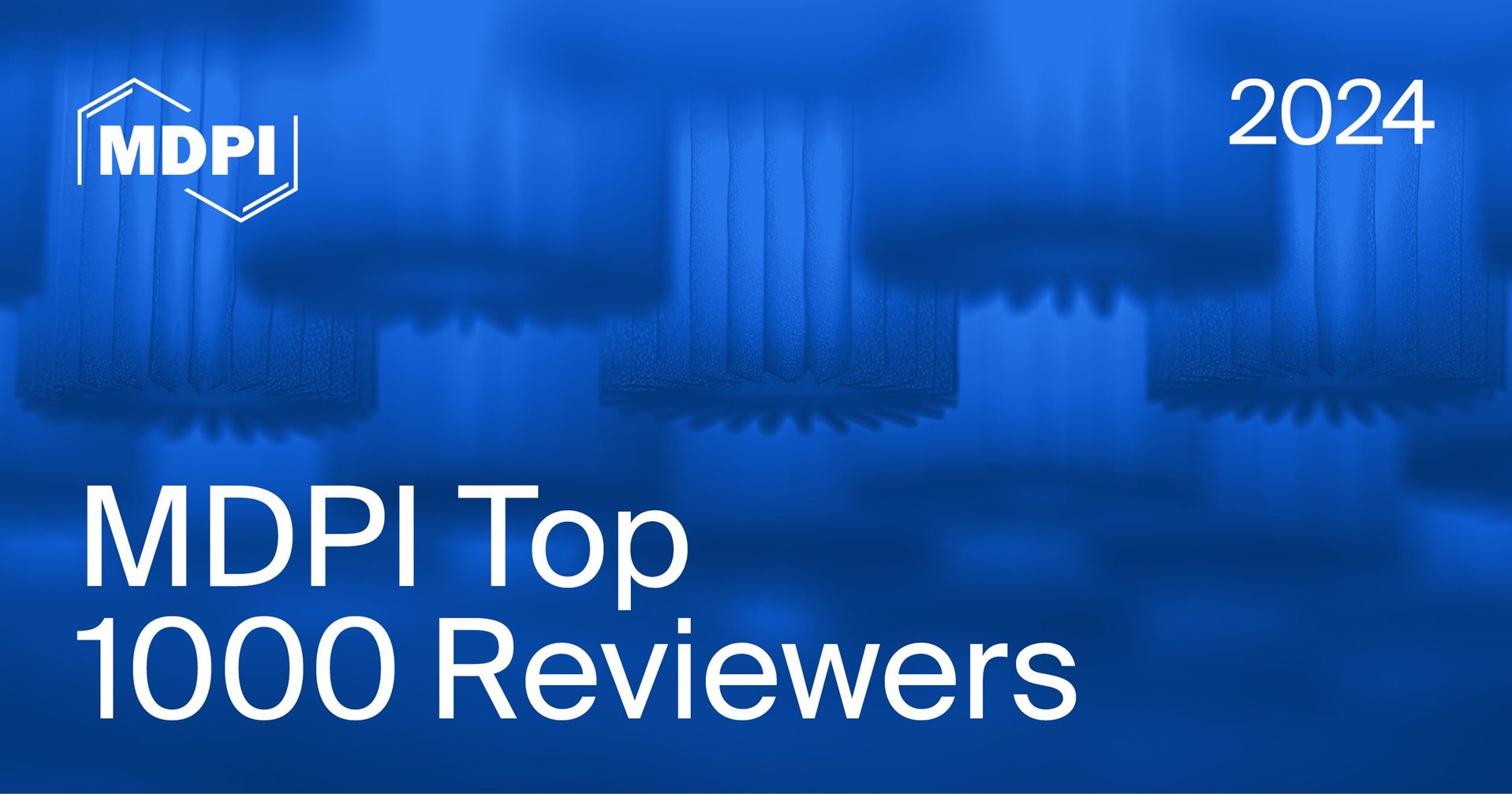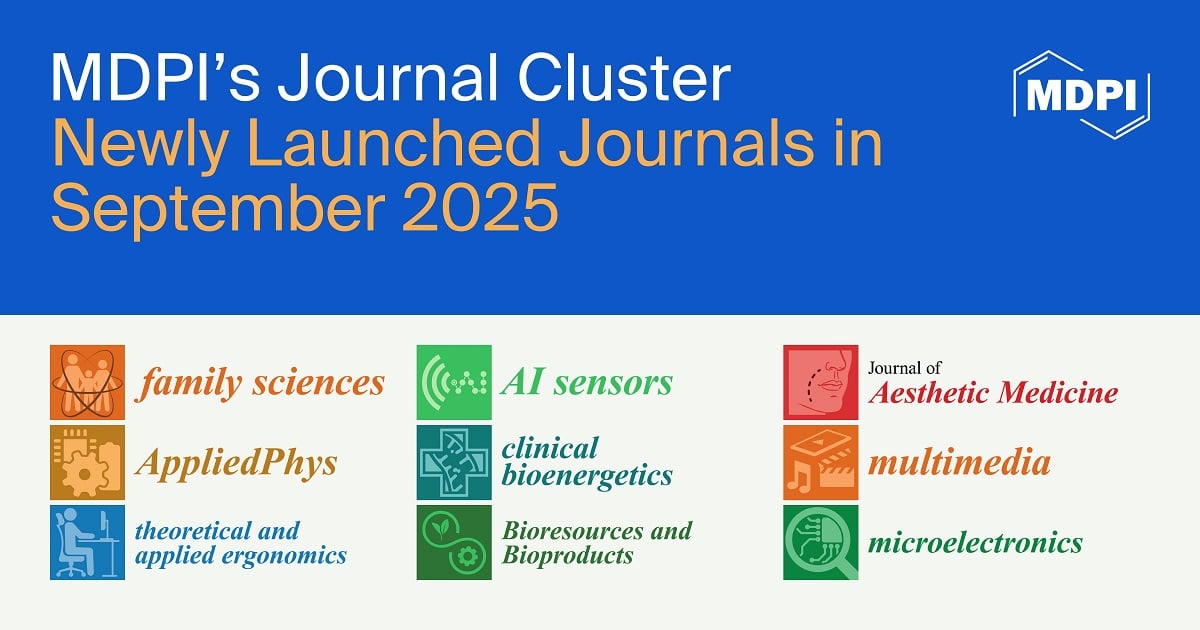-
 Infertility and Auto-Antibodies: A Review
Infertility and Auto-Antibodies: A Review -
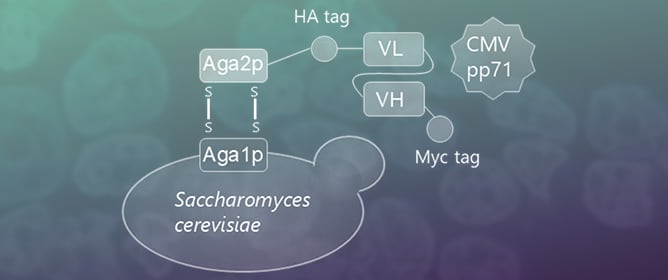 Isolation of a Monoclonal Human scFv Against Cytomegalovirus pp71 Antigen Using Yeast Display
Isolation of a Monoclonal Human scFv Against Cytomegalovirus pp71 Antigen Using Yeast Display -
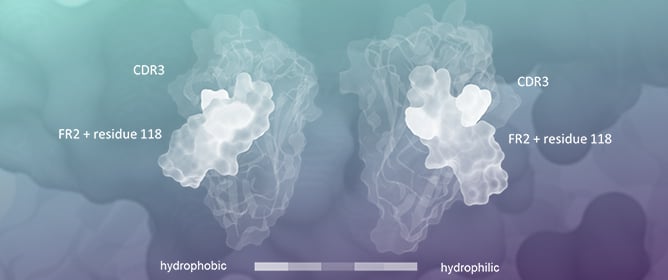 Computational Prediction of Single-Domain Immunoglobulin Aggregation Propensities Facilitates Discovery and Humanization of Recombinant Nanobodies
Computational Prediction of Single-Domain Immunoglobulin Aggregation Propensities Facilitates Discovery and Humanization of Recombinant Nanobodies -
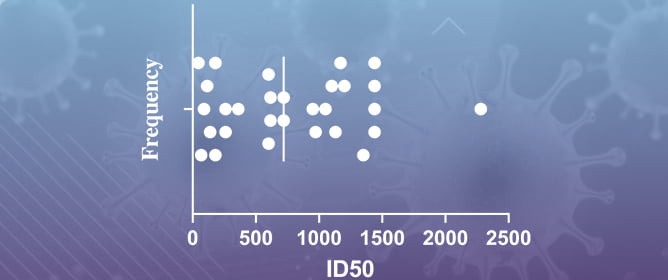 Loss of IgA and IgM Compromises Broad Neutralization of Structurally Divergent SARS-CoV-2 Variants
Loss of IgA and IgM Compromises Broad Neutralization of Structurally Divergent SARS-CoV-2 Variants -
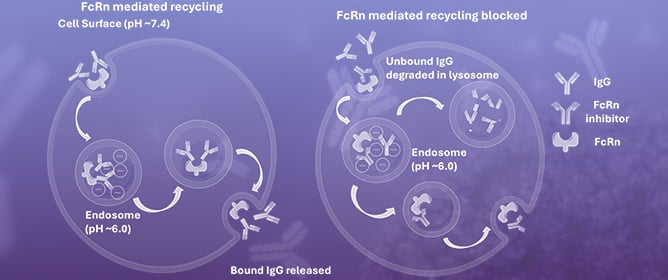 FcRn Blockade as a Targeted Therapeutic Strategy in Antibody-Mediated Autoimmune Diseases: A Focus on Warm Autoimmune Hemolytic Anemia
FcRn Blockade as a Targeted Therapeutic Strategy in Antibody-Mediated Autoimmune Diseases: A Focus on Warm Autoimmune Hemolytic Anemia
Journal Description
Antibodies
Antibodies
is an international, peer-reviewed, open access journal on immunoglobulins, published quarterly online by MDPI.
- Open Access— free for readers, with article processing charges (APC) paid by authors or their institutions.
- High Visibility: indexed within Scopus, ESCI (Web of Science), PubMed, PMC, Embase, CAPlus / SciFinder, and other databases.
- Journal Rank: CiteScore - Q2 (Drug Discovery)
- Rapid Publication: manuscripts are peer-reviewed and a first decision is provided to authors approximately 22.2 days after submission; acceptance to publication is undertaken in 4.6 days (median values for papers published in this journal in the first half of 2025).
- Recognition of Reviewers: reviewers who provide timely, thorough peer-review reports receive vouchers entitling them to a discount on the APC of their next publication in any MDPI journal, in appreciation of the work done.
Impact Factor:
2.7 (2024);
5-Year Impact Factor:
4.7 (2024)
Latest Articles
N-Glycosylation of Antibodies: Biological Effects During Infections and Therapeutic Applications
Antibodies 2025, 14(4), 93; https://doi.org/10.3390/antib14040093 - 28 Oct 2025
Abstract
Antibodies are produced by cells of the adaptive immune response and recognize epitopes of microbial structures with high affinity and specificity. Antibodies are recognized by Fc fragment receptors (FcRs) found on the surface of phagocytic cells (neutrophils, monocytes, macrophages) and NK cells, among
[...] Read more.
Antibodies are produced by cells of the adaptive immune response and recognize epitopes of microbial structures with high affinity and specificity. Antibodies are recognized by Fc fragment receptors (FcRs) found on the surface of phagocytic cells (neutrophils, monocytes, macrophages) and NK cells, among others. Hence, antibodies link the adaptive immune response with the innate immune response. The functions of antibodies are related to the N-glycosylation profile of these proteins. In this review, we describe how N-glycosylation of the Fc fragment of the different antibody classes is carried out, and which oligosaccharides are most commonly found in these antibodies. Subsequently, we summarize the biological effects of N-glycosylation of antibodies: on the binding of antibodies to FcRs (which affects various functions, such as antibody-dependent cellular cytotoxicity, antibody-dependent phagocytosis, and the production of pro- or anti-inflammatory chemokines and cytokines), on the ability of antibodies to activate complement and on the ability of some antibodies to directly neutralize the adhesion of bacteria and viruses to host cells (independently of Fab recognition). We describe how the N-glycosylation profile of antibodies is modified during certain infections (such as tuberculosis, COVID-19, influenza and dengue) and in response to vaccination, and the potential use of this profile to identify the stage and severity of an infection. Finally, we review the importance of N-glycosylation for the pharmacokinetic, pharmacodynamic and safety profiles of therapeutic monoclonal antibodies.
Full article
(This article belongs to the Special Issue Therapeutic Antibodies: New Trends in Discovery, Developability and Characterization)
►
Show Figures
Open AccessReview
Rabbit-Derived Antithymocyte Globulin-Associated Perioperative Anaphylaxis in Renal Transplantation: A Multidisciplinary Perspective on Pathophysiology, Clinical Presentation, and Management
by
Imran Gani, Usman Baig, Ahmad Mirza, Shais Jallu and Abrar Ahad Chawdhary
Antibodies 2025, 14(4), 92; https://doi.org/10.3390/antib14040092 - 28 Oct 2025
Abstract
Rabbit antithymocyte globulin is one of the most commonly used agents for induction immunosuppression in renal transplantation. It has contributed significantly to improved allograft survival and has a favorable safety profile. Despite its advantages, rabbit antithymocyte globulin carries a rare but potentially life-threatening
[...] Read more.
Rabbit antithymocyte globulin is one of the most commonly used agents for induction immunosuppression in renal transplantation. It has contributed significantly to improved allograft survival and has a favorable safety profile. Despite its advantages, rabbit antithymocyte globulin carries a rare but potentially life-threatening risk of anaphylaxis, which can lead to severe morbidity and mortality. Anaphylaxis is an acute and dramatic complication that requires prompt recognition and immediate management. In this review, we discuss the pathophysiology, clinical features, and management of rabbit antithymocyte globulin-associated anaphylaxis. We have also included practical insights from our clinical experience to guide early recognition and management, aiming to help clinicians safely manage this critical adverse event.
Full article
(This article belongs to the Section Antibody-Based Therapeutics)
►▼
Show Figures
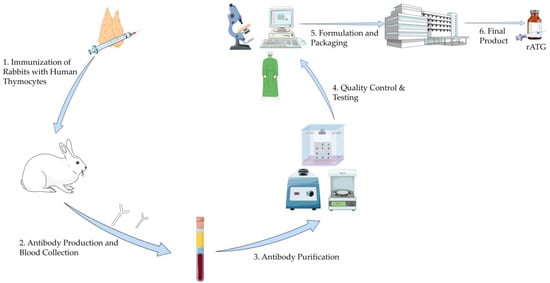
Figure 1
Open AccessArticle
Evaluating the Role of Basiliximab Induction in Simultaneous Liver–Kidney Transplantation: A Multicenter Propensity-Score-Matched Analysis
by
Avery Koi, Trine Engebretsen, Alfred S. Lea, Daniel Arango, Heather L. Stevenson and Michael L. Kueht
Antibodies 2025, 14(4), 91; https://doi.org/10.3390/antib14040091 - 28 Oct 2025
Abstract
Introduction: Simultaneous liver–kidney (SLK) transplant recipients are considered at lower immunologic risk than kidney-alone recipients, so steroid-only induction is often used. However, some centers continue to include basiliximab induction in their protocols. This study compared graft and infectious outcomes in SLK recipients receiving
[...] Read more.
Introduction: Simultaneous liver–kidney (SLK) transplant recipients are considered at lower immunologic risk than kidney-alone recipients, so steroid-only induction is often used. However, some centers continue to include basiliximab induction in their protocols. This study compared graft and infectious outcomes in SLK recipients receiving basiliximab (Bas) induction versus those without basiliximab (No Bas). Methods: Using TriNetX, we conducted a retrospective, propensity-score-matched study of SLK recipients comparing 3-, 6-, and 12-month graft and infectious outcomes. Patients receiving alemtuzumab or anti-thymocyte globulin were excluded; steroid induction was permitted but not required in either cohort. Maintenance immunosuppression included tacrolimus, mycophenolate, and prednisone. Cohorts were matched on 71 variables, including demographics, disease etiology, severity markers, and cPRA. Results: After matching, 292 patients were included per cohort (mean age 56.9 ± 10.1 years; 61% male). Kidney and liver rejection rates were similar. The No Bas cohort had more liver biopsies (25.5% vs. 18.2% at 1 year, p = 0.04). Kidney biopsy, graft failure, re-transplantation, delayed graft function, and mortality were comparable. Liver primary non-function was more frequent in Bas (2.8% vs. 0.4%, p = 0.04). The No Bas cohort had higher CMV at 3 months (13.4% vs. 6.7%, p = 0.008) and higher EBV at all time points (4.0% vs. 0.4% at 1 year, p = 0.004). Conclusions: SLK recipients without basiliximab induction had comparable rejection outcomes but more viral infections, potentially from greater steroid exposure, and more liver biopsies, which may reflect higher clinical suspicion for rejection or incomplete capture of rejection events in EMR data.
Full article
(This article belongs to the Special Issue Antibody-Mediated Rejection in Kidney Transplantation)
►▼
Show Figures
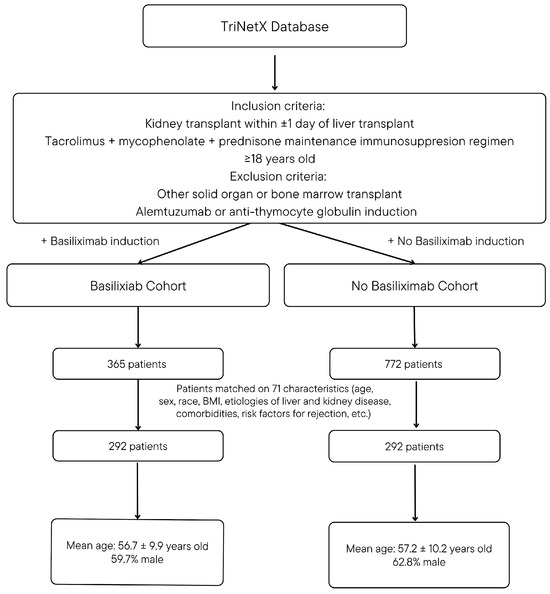
Figure 1
Open AccessArticle
Evaluating the Therapeutic Efficacy of an Anti-BAFF Receptor Antibody Using a Rheumatoid Arthritis Mouse Model
by
Adi Aharon, Rachel Birnboim-Perach, Omer Grotto, Adi Amir, Daniel Diadko, Nitzan Beltran, Limor Nahary and Itai Benhar
Antibodies 2025, 14(4), 90; https://doi.org/10.3390/antib14040090 - 20 Oct 2025
Abstract
Background: Rheumatoid arthritis (RA) is a chronic autoimmune disease characterized by joint inflammation that leads to tissue damage and disability. RA affects approximately 0.5–1% of the global population and is driven by a complex interplay of genetic susceptibility, environmental factors, and immune dysregulation.
[...] Read more.
Background: Rheumatoid arthritis (RA) is a chronic autoimmune disease characterized by joint inflammation that leads to tissue damage and disability. RA affects approximately 0.5–1% of the global population and is driven by a complex interplay of genetic susceptibility, environmental factors, and immune dysregulation. While biologic and targeted synthetic DMARDs improved RA treatment, they have limitations in efficacy, safety, and accessibility. B-cell-targeting therapies, such as anti-CD20, have shown effectiveness, but only with broad immunosuppression, which can increase infection risk and compromise humoral immunity. Therefore, there is an unmet need for more selective therapeutic strategies that modulate pathogenic immune pathways while preserving protective immune functions. It has been suggested that targeting the BAFF pathway may offer a more favorable therapeutic approach compared to targeting CD20. Objectives: In this study, we evaluated the therapeutic potential of V3-46s mIgG2a, an anti-BAFF-R (BR3) antibody in a mouse RA model, hypothesizing that it would offer a more selective and effective strategy. Methods: We expressed and purified four antibody variants and assessed their binding and neutralizing activity in vitro. V3-46s mIgG2a was selected for in vivo evaluation in a collagen-induced arthritis (CIA) model. Results: Treatment with this antibody delayed disease onset and reduced arthritis severity, spleen index, and B-cell populations. Conclusions: These findings highlight the potential of BAFF-R-targeting antibodies as a therapeutic approach for RA treatment. This preclinical work lays the groundwork for future development of BAFF-R blockade as a complementary or alternative strategy to current biologic treatments.
Full article
(This article belongs to the Section Antibody-Based Therapeutics)
►▼
Show Figures

Figure 1
Open AccessArticle
Enhanced ADCC Activity of a C-Terminal Lysine Variant of an IgG1 Antibody Driven by N-Linked MAN5 Glycan Using a Reporter Gene Assay
by
Ming-Ching Hsieh, Kristiina Dorofejeva, Jingming Zhang, Diane L. Vy, Jun Qian, Alice M. Matathia, Timothy Blanc, Chao Richard Li and Babita S. Parekh
Antibodies 2025, 14(4), 89; https://doi.org/10.3390/antib14040089 - 17 Oct 2025
Abstract
Background: Antibody-dependent cellular cytotoxicity (ADCC) is an immune response where antibodies bind to target cells and activate effector cells through Fcγ receptors, ultimately leading to the destruction of the target cells. Methods: This study examined the ADCC activities of charge variants of a
[...] Read more.
Background: Antibody-dependent cellular cytotoxicity (ADCC) is an immune response where antibodies bind to target cells and activate effector cells through Fcγ receptors, ultimately leading to the destruction of the target cells. Methods: This study examined the ADCC activities of charge variants of a therapeutic IgG1, MAB1, using an internally developed reporter gene assay. In this assay, the proprietary target was expressed on DiFi cells, while FcγRIIIa was expressed on Jurkat effector cells. Results: The results revealed that different charge variants had varying levels of ADCC activity, with variants containing C-terminal lysine residues showing enhanced activity. The charge variants arose from modifications such as the presence of sialic acid at the glycan moiety, deamidation, and C-terminal lysine truncation, including K2 (two C-terminal lysine residues), K1 (one C-terminal lysine residue), and K0 (no C-terminal lysine residues) variants. Notably, the K1 and K2 variants demonstrated higher ADCC activity compared to the K0 and acidic variants. However, the observed increase was attributed not to the lysine residue itself, but rather to the MAN5 glycan associated with the lysine-containing variants. Conclusion: These findings challenge previous assumptions about the role of C-terminal lysine in ADCC, suggesting a shift in understanding the functional significance of charge variants and emphasizing the critical influence of glycan composition in therapeutic antibody efficacy.
Full article
(This article belongs to the Section Antibody-Based Therapeutics)
►▼
Show Figures

Graphical abstract
Open AccessArticle
Modulating Subcellular Localization to Preserve the Stability and Functionality of Intracellular Nanobodies
by
Wenli Sun, Keke Huang, Yaping Cheng, Ailing Huang, Yu Kong, Jun Lu, Tianlei Ying and Yanling Wu
Antibodies 2025, 14(4), 88; https://doi.org/10.3390/antib14040088 - 16 Oct 2025
Abstract
Background: Antibodies have revolutionized therapeutics and diagnostics, but their applications are largely restricted to extracellular targets due to challenges in intracellular delivery and stability. Nanobodies, with their small size and lack of disulfide bonds, hold great promise for intracellular use but face challenges
[...] Read more.
Background: Antibodies have revolutionized therapeutics and diagnostics, but their applications are largely restricted to extracellular targets due to challenges in intracellular delivery and stability. Nanobodies, with their small size and lack of disulfide bonds, hold great promise for intracellular use but face challenges such as aggregation and rapid degradation in the cytosol. Methods: To overcome this, we engineered nanobodies by fusing them with subcellular localization motifs to redirect their localization within cells, including the mitochondrial surface, endoplasmic reticulum surface, endomembrane system, and cytoskeleton. Results: Our results demonstrate that nanobodies located in the cytoskeleton or endomembrane exhibit significantly reduced degradation rates and enhanced stability, while maintaining their target-binding capacity. Mechanistically, these modifications lowered ubiquitination levels and prolonged functional activity. Conclusions: This work provides a novel strategy to enhance the intracellular stability and efficacy of nanobodies, expanding their potential applications in functional proteomics, disease research, and therapeutic development.
Full article
(This article belongs to the Section Antibody Discovery and Engineering)
►▼
Show Figures

Graphical abstract
Open AccessArticle
A Robust, High-Titer, Semi-Automated, and In-Culture Antibody-Capturing Transient CHO Platform Technology
by
Lauren Gebhardt, Molica Abel, Jing Zhou, Audrey M. Vogt, Bo Hee Shin, Sarah L. Herrick Wagman, Ana Santos, Jerome Puginier, Florian M. Wurm, Maria J. Wurm, Guoying Grace Yan, Adedolapo Adeniyi, Sean K. H. Lim, Will Somers, Laura Lin, Aaron M. D’Antona and Xiaotian Zhong
Antibodies 2025, 14(4), 87; https://doi.org/10.3390/antib14040087 - 11 Oct 2025
Abstract
Background: Recent advances in antibody discovery technologies, especially progress in de novo synthesis through machine learning, have imposed a significant production challenge for the generation of a large diversity of antibodies against nearly any target of interest. There is a demand for the
[...] Read more.
Background: Recent advances in antibody discovery technologies, especially progress in de novo synthesis through machine learning, have imposed a significant production challenge for the generation of a large diversity of antibodies against nearly any target of interest. There is a demand for the rapid production of dozens of purified antibodies in 10-milligram quantities sufficient for functional screening and molecular assessment studies. Objectives: To meet this requirement, a semi-automated production methodology and workflow was developed to bridge the miniaturized high-throughput screenings (HTSs) and the conventional custom-scale workflow by taking advantage of four new technology applications. Methods: First, it exploited a novel, simple, high-titer transient expression system, “CHO4Tx®”, which could achieve high yields in the range of 200 mg/L and above, across a variety of antibody constructs, including challenging targets. The consistently high yields from this transient CHO platform enabled the delivery of ~20 mg of crude material per 100 mL scale flask production with a throughput capacity of nineteen constructs in a single run. Secondly, we established a magnetic ProA bead in-culture antibody-capturing process, which significantly shortened the production timeline by eliminating the steps of cell centrifugation, filtration, and medium column loading. Third, we utilized the GenScript AmMag™ SA Plus semi-automation, which could handle magnetic ProA bead elution for 12 constructs within less than 1 h. Lastly, we transformed the AKTA PureTM system into an automated buffer exchange purification system with a capacity of processing 19 samples in a single run. Results and Conclusions: This new production platform was proven to be robust and could be applied for the routine production of antibodies of sufficient quality and quantity in support of cell-based assays and biophysical characterization.
Full article
(This article belongs to the Special Issue A Festschrift Celebrating Dr. Dimiter Stanchev Dimitrov: Antibodies, Innovation, and Impact on Infectious Disease and Cancer Research)
►▼
Show Figures

Graphical abstract
Open AccessArticle
Structural and Functional Characterization of Anti-SARS-CoV-2 Spike Monoclonal Antibodies Produced via Bicistronic Expression in CHO Cells
by
Federico Francisco Marsili, Fernanda Bittencourt de Aquino, Hiam Rodrigo da Silva Arruda, Mayra Amorim Marques, Katia Maria dos Santos Cabral, Marcius da Silva Almeida, Guilherme Augusto Piedade de Oliveira, Andrea Queiroz Maranhão, Renato Sampaio Carvalho and Leda dos Reis Castilho
Antibodies 2025, 14(4), 86; https://doi.org/10.3390/antib14040086 - 9 Oct 2025
Abstract
Background: Recombinant monoclonal antibodies (mAbs) represent the fastest-growing sector of the biopharmaceutical industry, with their efficient expression being a key technological factor for scalability. Objectives: In this study we compared the performance of two bicistronic vectors, which alternate the positions of the light
[...] Read more.
Background: Recombinant monoclonal antibodies (mAbs) represent the fastest-growing sector of the biopharmaceutical industry, with their efficient expression being a key technological factor for scalability. Objectives: In this study we compared the performance of two bicistronic vectors, which alternate the positions of the light and heavy chain coding genes, employing a wild-type Encephalomyocarditis virus (EMCV) IRES functional element to drive expression of the second gene. Methods: Using two neutralizing anti-SARS-CoV-2 IgG1 antibodies as model molecules, we conducted transient transfections in the commercially available ExpiCHOTM platform. Following protein A affinity purification and quantification, vectors positioning the light chain as the first cistron consistently yielded higher expression levels than those with the heavy chain upstream. To confirm the quality attributes of the mAbs, we applied a comprehensive analytical workflow, including SDS-PAGE and Western blot for molecular mass and purity, circular dichroism for secondary structure, intrinsic tryptophan fluorescence for tertiary structure, and SEC-HPLC for quaternary structure and aggregate detection. Additionally, we assessed binding affinity to the target using spot blot and surface plasmon resonance, analyzed N-glycosylation profiles by HILIC-HPLC and mass spectrometry, and examined molecular structure by transmission electron microscopy. Results and Conclusions: Together, these results provide insight into the impact of gene positioning within bicistronic vectors on mAb expression efficiency and quality, supporting optimization strategies for scalable recombinant antibody production.
Full article
(This article belongs to the Special Issue A Festschrift Celebrating Dr. Dimiter Stanchev Dimitrov: Antibodies, Innovation, and Impact on Infectious Disease and Cancer Research)
►▼
Show Figures

Graphical abstract
Open AccessArticle
Monoclonal Antibodies Can Aid in the Culture-Based Detection and Differentiation of Mucorales Fungi—The Flesh-Eating Pathogens Apophysomyces and Saksenaea as an Exemplar
by
Christopher R. Thornton and Genna E. Davies
Antibodies 2025, 14(4), 85; https://doi.org/10.3390/antib14040085 - 7 Oct 2025
Abstract
Background: The frequency of necrotising cutaneous and soft tissue infections caused by the Mucorales fungi Apophysomyces and Sakasenaea is increasing. The absence of sophisticated diagnostic technologies in low- and middle-income countries (LMICs) means that detection of cutaneous mucormycosis continues to rely on culture
[...] Read more.
Background: The frequency of necrotising cutaneous and soft tissue infections caused by the Mucorales fungi Apophysomyces and Sakasenaea is increasing. The absence of sophisticated diagnostic technologies in low- and middle-income countries (LMICs) means that detection of cutaneous mucormycosis continues to rely on culture of the infecting pathogens from biopsy and their differentiation based on morphological characteristics. However, Apophysomyces and Sakasenaea are notorious for their failure to sporulate on standard mycological media used for the identification of human pathogenic fungi. Differentiation of these pathogens and their discrimination from Aspergillus fumigatus, the most common mould pathogen of humans, is essential due to their differing sensitivities to the antifungal drugs used to treat mucormycosis. Methods: A murine IgG1 monoclonal antibody, JD4, has been developed that is specific to Apophysomyces species. In Western blotting and enzyme-linked immunosorbent assay (ELISA), mAb JD4 is shown to bind to an extracellular 15 kDa protein, readily detectable in crude antigen extracts from non-sporulating cultures of Apophysomyces. Results: When combined with a Mucorales-specific lateral-flow immunoassay (LFIA), mAb JD4 allows the differentiation of Apophysomyces from Saksenaea species and discrimination from Aspergillus fumigatus. Monoclonal antibody JD4 enables the detection and differentiation of Apophysomyces species from other fungal pathogens that cause rapidly progressive cutaneous and soft tissue mycoses in humans. When this is combined with a rapid LFIA, improvements are offered in the sensitivity and specificity of Mucorales detection based on mycological culture, which remains a gold-standard procedure for mucormycosis detection in LMICs lacking access to more sophisticated diagnostic procedures.
Full article
(This article belongs to the Section Antibody-Based Diagnostics)
►▼
Show Figures

Figure 1
Open AccessArticle
Novel Humanized Anti-HER3 Antibodies: Structural Characterization and Therapeutic Activity
by
Alessia Muzi, Roberto Arriga, Giovanni Bulfaro, Francesca Fata, Antonella Costanzo, Valerio Chiarini, Manuela Cappelletti, Fabiana Fosca Ferrara, Federica Bucci, Linda Celeste Montemiglio, Carmelinda Savino, Emanuele Marra, Gennaro Ciliberto, Luigi Aurisicchio, Beatrice Vallone and Giuseppe Roscilli
Antibodies 2025, 14(4), 84; https://doi.org/10.3390/antib14040084 - 6 Oct 2025
Abstract
Background/Objectives: The ErbB protein family plays a critical role in the progression of various solid tumors, and HER3 has been implicated in resistance mechanisms to multiple cancer therapies due to its ability to form heterodimers with other ErbB receptors, thereby activating pathways that
[...] Read more.
Background/Objectives: The ErbB protein family plays a critical role in the progression of various solid tumors, and HER3 has been implicated in resistance mechanisms to multiple cancer therapies due to its ability to form heterodimers with other ErbB receptors, thereby activating pathways that promote tumor growth and survival. This study aimed to generate and characterize humanized monoclonal antibodies against HER3 to inhibit its function and evaluate their potential as therapeutic agents. Methods: Murine monoclonal antibodies TK-A3 and TK-A4 were humanized and tested for binding to ErbB3 and competition with neuregulin-1β (NRG). Specificity was assessed by ELISA, and epitope identified by X-ray crystallography. Downstream signaling was analyzed by western blot for phosphorylated ErbB3, Akt, and MAPK. Antitumor activity was evaluated in vitro and in a pancreatic cancer xenograft model. A toxicology study was also conducted. Results: TK-hu A3 and TK-hu A4 bound specifically to ErbB3 without cross-reactivity to other ErbB receptors. The ErbB3-TK-hu A3 Fab structure revealed the binding epitope. Both antibodies competed with NRG, inhibiting ErbB3, Akt, and MAPK phosphorylation in a dose-dependent manner. They suppressed cancer cell survival in vitro, and TK-hu A3 significantly delayed tumor growth in vivo. The toxicology study indicated good tolerability. Conclusions: TK-hu A3 emerged as the lead candidate, showing specific HER3 targeting, strong pathway inhibition, and antitumor efficacy in vivo. Beyond standalone use, it could support novel strategies such as T-cell engagers, ADCs, CAR-T, and bispecific antibodies. These findings highlight TK-hu A3 as a promising therapy for HER3-positive, treatment-resistant cancers, meriting further development.
Full article
(This article belongs to the Section Antibody-Based Therapeutics)
►▼
Show Figures

Figure 1
Open AccessArticle
Generation Using Phage-Display of pH-Dependent Antibodies Against the Tumor-Associated Antigen AXL
by
Tristan Mangeat, Célestine Mairaville, Myriam Chentouf, Madeline Neiveyans, Martine Pugnière, Giang Ngo, Vincent Denis, Corentin Catherine, Alexandre Pichard, Emmanuel Deshayes, Margaux Maurel, Matthieu Gracia, Anne Bigot, Vincent Mouly, Sébastien Estaran, Alain Chavanieu, Pierre Martineau and Bruno Robert
Antibodies 2025, 14(4), 83; https://doi.org/10.3390/antib14040083 - 30 Sep 2025
Abstract
Background/Objectives: Tumor-associated antigens are not tumor-specific antigens but proteins that are overexpressed by tumor cells and also weakly expressed at the surface of healthy tissues. Therefore, some side effects are observed when targeted by therapeutic antibodies, a phenomenon named “on-target, off-tumor toxicity”. As
[...] Read more.
Background/Objectives: Tumor-associated antigens are not tumor-specific antigens but proteins that are overexpressed by tumor cells and also weakly expressed at the surface of healthy tissues. Therefore, some side effects are observed when targeted by therapeutic antibodies, a phenomenon named “on-target, off-tumor toxicity”. As tumors generate an acidic microenvironment, we investigated whether we could generate pH-dependent antibodies to increase their tumor specificity. For this proof-of-concept study, we selected the tyrosine kinase receptor AXL because we already developed several antibodies against this target. Methods: To generate a pH-dependent anti-AXL antibody, we performed classical panning of a single-chain variable fragment (scFv) library using phage display at an acidic pH throughout the process. Results: After the third round of panning, 9 scFvs, among the 96 picked clones, bound to AXL at acidic pH and showed very low binding at a neutral pH. After reformatting them into IgG, two clones were selected for further study due to their strong pH-sensitive binding. Using molecular docking and alanine scanning, we found that their binding strongly depended on two histidine residues present on AXL at positions 61 and 116. Conclusions: To conclude, we set-up an easy process to generate pH-dependent antibodies that may increase their tumor-binding specificity and potentially decrease toxicity towards healthy tissues.
Full article
(This article belongs to the Section Antibody Discovery and Engineering)
►▼
Show Figures

Figure 1
Open AccessReview
Serum Factors in Primary Podocytopathies
by
Edward John Filippone and John L. Farber
Antibodies 2025, 14(4), 82; https://doi.org/10.3390/antib14040082 - 28 Sep 2025
Abstract
Primary podocytopathies, including minimal change disease (MCD) and focal segmental glomerulosclerosis (FSGS), are caused by a circulating factor or factors injurious to the podocyte. An immunologic origin seems likely based on responsiveness to corticosteroids or other immunosuppressive agents, including calcineurin inhibitors targeting T-cells
[...] Read more.
Primary podocytopathies, including minimal change disease (MCD) and focal segmental glomerulosclerosis (FSGS), are caused by a circulating factor or factors injurious to the podocyte. An immunologic origin seems likely based on responsiveness to corticosteroids or other immunosuppressive agents, including calcineurin inhibitors targeting T-cells and rituximab targeting B-cells. Potential non-antibody-mediated circulating factors have been identified, including cardiotrophin-like cytokine 1, soluble urokinase plasminogen activator receptor, and angiopoietin-like 4, among others. More recent research supports a primary antibody pathogenesis, with anti-nephrin antibodies found in a significant percentage of cases. Such antibodies also predict recurrence after transplantation. Other potential antigenic targets besides nephrin include annexin, the proteosome, podocin, and CD40. Additionally, high-resolution confocal microscopy has identified punctate immunoglobulin deposits along the slit diaphragm and podocyte cell body that may or may not colocalize with abnormal punctate nephrin staining and may correlate with detectable circulating antibodies. The success of rituximab in observational studies in both native kidneys and transplants supports a primary role for autoantibodies. We discuss in detail the data supporting putative non-antibody circulating factors, as well as the recent data supporting antibody pathogenesis, which may provide some clues on treating the individual patient.
Full article
(This article belongs to the Section Humoral Immunity)
Open AccessArticle
Purification and Characterization of Immunoglobulin Y (IgY) Targeting Surface Antigen 1 (SAG1) of Toxoplasma gondii
by
Enrique Adrián Herrera-Aguirre, Diana León-Núñez, Jaime Marcial-Quino, Saúl Gómez-Manzo, César Augusto Reyes-López, Yolanda Medina-Flores, Olga Mata-Ruíz, Lizbeth Xicotencatl-García, Hector Luna-Pastén, Luz Belinda Ortiz-Alegría, Nury Pérez-Hernández, Magdalena Escorcia, Dolores Correa and Fernando Gómez-Chávez
Antibodies 2025, 14(4), 81; https://doi.org/10.3390/antib14040081 - 26 Sep 2025
Abstract
Toxoplasma gondii (T. gondii) is an obligate intracellular protozoan parasite responsible for toxoplasmosis, a disease with significant health implications for humans and animals. The surface antigen 1 (SAG1) of T. gondii is a major immunodominant protein that facilitates host cell invasion,
[...] Read more.
Toxoplasma gondii (T. gondii) is an obligate intracellular protozoan parasite responsible for toxoplasmosis, a disease with significant health implications for humans and animals. The surface antigen 1 (SAG1) of T. gondii is a major immunodominant protein that facilitates host cell invasion, making it an ideal target for diagnostic and therapeutic interventions. Immunoglobulin Y (IgY), the primary antibody in avian species, offers unique advantages over mammalian IgG, including easier animal care, lower costs, high-yield production, and potential passive immunization. Objectives: This study aimed to induce, purify, and characterize IgY antibodies targeting T. gondii SAG1 from hen egg yolks. Methods: The coding region of the mature portion of T. gondii SAG1 was amplified by PCR, cloned into the pET32a(+) vector for heterologous expression in E. coli. The recombinant SAG1 (rSAG1) was purified by affinity chromatography and used to immunize hens. IgY was extracted from egg yolks using PEG. SDS-PAGE and spectrophotometry were used to evaluate purity and concentration. By ELISA, Western blot, and flow cytometry, the specificity of IgY was assessed against recombinant and endogenous, native, and denatured SAG1. Results: Purified IgY demonstrated strong recognition of both recombinant and native SAG1 in ELISA and Western blot, and against T. gondii tachyzoites by flow cytometry. Conclusions: SAG1-specific IgY was produced in a pure form; it could be helpful in research, diagnosis, and treatment at low costs on a larger production scale, with minimal animal harm.
Full article
(This article belongs to the Section Antibody Discovery and Engineering)
►▼
Show Figures

Figure 1
Open AccessArticle
Development of a Chicken Immunoglobulin Heavy Chain Variable Region (VH) Single-Domain Antibody (sdAb) Against Calsequestrin (CSQ) and Its Application
by
Sun Lee, Seoryeong Park, Hyunji Yang, Geummi Cho, Seung Youn Lee, Donggeun Lee, Nara Tae, Dae Hee Kim and Junho Chung
Antibodies 2025, 14(3), 80; https://doi.org/10.3390/antib14030080 - 19 Sep 2025
Abstract
Background/Objectives: Calsequestrin (CSQ) is a calcium-binding protein that is highly soluble and can serve as a solubility-enhancing fusion tag in recombinant protein expression. Its unique property of calcium-induced precipitation followed by EDTA-mediated resolubilization enables efficient purification. However, the broader application of CSQ-tagged proteins
[...] Read more.
Background/Objectives: Calsequestrin (CSQ) is a calcium-binding protein that is highly soluble and can serve as a solubility-enhancing fusion tag in recombinant protein expression. Its unique property of calcium-induced precipitation followed by EDTA-mediated resolubilization enables efficient purification. However, the broader application of CSQ-tagged proteins in research have been hampered by the lack of reliable anti-CSQ detection reagents. This study aimed to develop single-domain antibodies (sdAbs) against CSQ for use in diverse immunoassays and cell-based analyses. Methods: Single-domain antibodies were selected from phage-displayed chicken VH libraries generated from CSQ-immunized chickens. After biopanning, CSQ-specific VH sdAb clones were isolated and expressed as VH–human kappa light chain constant region (VH-Cκ) fusion proteins in E. coli. The PE06 clone was chosen for further characterization and conjugated to horseradish peroxidase (HRP) and Alexa Fluor 647 for assay applications. Results: PE06 VH-Cκ fusion protein demonstrated specific binding to CSQ-tagged proteins and enabled reliable detection in enzyme-linked immunosorbent assay (ELISA), immunoblotting, and flow cytometry. These results validated its utility as a chemically defined detection reagent for CSQ fusion proteins expressed in E. coli. Conclusions: This study establishes a CSQ-specific chicken VH sdAb as a versatile detection tool for CSQ-tagged proteins. The approach expands the utility of CSQ as a protein fusion tag and enables the development of recombinant antibodies fused with CSQ, such as scFv-CSQ constructs, for broad application in research and assay systems.
Full article
(This article belongs to the Section Antibody Discovery and Engineering)
►▼
Show Figures

Figure 1
Open AccessReview
Monoclonal Antibodies and Small-Molecule Therapies for Lichen Planus: Targeted Immunomodulation and Emerging Evidence
by
Francois Rosset, Nadia Sciamarrelli, Luca Mastorino, Valentina Pala, Sara Boskovic, Eleonora Bongiovanni, Orsola Crespi, Yingying Liao, Simone Ribero and Pietro Quaglino
Antibodies 2025, 14(3), 79; https://doi.org/10.3390/antib14030079 - 17 Sep 2025
Abstract
Background/Objectives: Lichen planus (LP) is a chronic inflammatory disease of autoimmune origin, affecting the skin and mucous membranes. While corticosteroids and immunosuppressants are traditionally used, many cases remain refractory or intolerant to standard therapies. Recent advances in immunopathogenesis have led to the exploration
[...] Read more.
Background/Objectives: Lichen planus (LP) is a chronic inflammatory disease of autoimmune origin, affecting the skin and mucous membranes. While corticosteroids and immunosuppressants are traditionally used, many cases remain refractory or intolerant to standard therapies. Recent advances in immunopathogenesis have led to the exploration of targeted therapies, including biologic agents and small-molecule inhibitors. Methods: This review synthesizes current evidence from case reports, case series, and observational studies on the use of monoclonal antibodies (anti-TNF-α, anti-IL-17, anti-IL-23, anti-IL-6) and JAK inhibitors in LP. A structured literature search was conducted across PubMed, Scopus, and Web of Science, focusing on studies published between 2010 and 2025. Data on mechanisms, clinical efficacy, safety, and research limitations were extracted and summarized. Results: Promising therapeutic responses were reported for IL-17 inhibitors (secukinumab, ixekizumab) and JAK inhibitors (tofacitinib, baricitinib) in mucosal and recalcitrant LP. Anti-TNF agents showed variable efficacy, while emerging targets such as BTK and IFN-γ are under investigation. Adverse events were generally mild to moderate, but long-term safety data are lacking. The absence of randomized controlled trials and standardized outcome measures limits generalizability. Conclusions: Biologic and small-molecule therapies represent a potential paradigm shift in the treatment of LP, offering targeted immunomodulation with promising efficacy in refractory cases. Further collaborative research, including randomized studies and biomarker-driven approaches, is urgently needed to validate these treatments and establish personalized care strategies.
Full article
(This article belongs to the Section Antibody-Based Therapeutics)
►▼
Show Figures

Graphical abstract
Open AccessReview
Advancing Antibody Titer Assessment in ABO-Incompatible Transplantation
by
Masayuki Tasaki, Kazuhide Saito and Kota Takahashi
Antibodies 2025, 14(3), 78; https://doi.org/10.3390/antib14030078 - 15 Sep 2025
Abstract
Background: The accurate evaluation of anti-ABO antibodies is essential for risk stratification in ABO-incompatible (ABOi) transplantation. Historically, hemagglutination-based titration has been the cornerstone of such an assessment; however, different tools are being evaluated in this context. In recent years, several novel methods
[...] Read more.
Background: The accurate evaluation of anti-ABO antibodies is essential for risk stratification in ABO-incompatible (ABOi) transplantation. Historically, hemagglutination-based titration has been the cornerstone of such an assessment; however, different tools are being evaluated in this context. In recent years, several novel methods have been reported. Methods: A narrative review was conducted using PubMed, Scopus, and Google Scholar, focusing on recent studies evaluating anti-ABO antibody measurement techniques in the context of ABOi organ transplantation. Results: In addition to the conventional tube method, techniques such as column agglutination technology, flow cytometry, and enzyme-linked immunosorbent assay are utilized for anti-ABO antibody assessment. However, any particular technique, significant interinstitutional and interoperator variabilities have been reported due to differences in the detailed protocols and the inherently subjective nature of some techniques. Moreover, these assays are based on the antibody binding to ABO antigens expressed on red blood cells, which might not accurately reflect the clinical context of organ transplantation. In recent years, technological advances have enabled the development of novel assays evaluating antibody responses specifically against the ABO antigens expressed on vascular endothelial cells. These include glycan microarrays, which differentiate responses by ABO antigen subtypes, and CD31-based microarrays, wherein recombinant CD31 proteins expressing ABO antigens are immobilized. These approaches are applied to assess clinically relevant anti-ABO antibodies in the context of ABOi organ transplantation. Conclusions: The objective evaluation of antibody titers against ABO antigens on vascular endothelial cells might not only enable a more accurate risk assessment but also facilitate meaningful comparisons between institutions.
Full article
(This article belongs to the Special Issue Antibody-Mediated Rejection in Kidney Transplantation)
►▼
Show Figures

Figure 1
Open AccessArticle
Comparative Evaluation of Three Primary Antibody Clones for p16 Immunohistochemistry in Gynecologic Tumors
by
Hiroshi Yoshida, Ayumi Sugitani, Mayumi Kobayashi-Kato, Masaya Uno and Mitsuya Ishikawa
Antibodies 2025, 14(3), 77; https://doi.org/10.3390/antib14030077 - 5 Sep 2025
Abstract
Background: p16 immunohistochemistry (IHC) serves as a surrogate marker for high-risk human papillomavirus (hrHPV) and is widely used in gynecologic pathology. However, few studies have directly compared the staining performance and reproducibility of different p16 antibody clones in this context. Methods: We retrospectively
[...] Read more.
Background: p16 immunohistochemistry (IHC) serves as a surrogate marker for high-risk human papillomavirus (hrHPV) and is widely used in gynecologic pathology. However, few studies have directly compared the staining performance and reproducibility of different p16 antibody clones in this context. Methods: We retrospectively evaluated 176 gynecologic tumor specimens including 42 whole slide sections and 134 tissue microarray cores from the cervix, endometrium, vulva, and ovary using three fully automated p16 IHC assays: E6H4 (Ventana/Roche), JC8 (Agilent/Dako), and 6H12 (Leica). Two pathologists independently reviewed each case, and concordance and interobserver agreement were analyzed. Sensitivity, specificity, and Cohen’s κ statistics were calculated, with E6H4 serving as the reference. Results: All three antibody clones demonstrated excellent staining performance with preserved tissue morphology and minimal background artifacts. Concordance for p16 positivity/negativity was 100% across all clone pairings (95% CI: 97.9–100%). Interobserver reproducibility was also perfect, with a κ coefficient of 1.00 (95% CI: 0.94–1.00). Minor non-block staining patterns did not impair interpretability. Conclusions: Our findings indicate that E6H4, JC8, and 6H12 clones yield comparable staining results when used in conjunction with standardized automated protocols. These results support the practical interchangeability of these clones in clinical and research settings, particularly when cost, availability, or risk management require substitution. Laboratories should continue to perform internal validation and utilize external quality assurance programs when implementing p16 IHC.
Full article
(This article belongs to the Section Antibody-Based Diagnostics)
►▼
Show Figures

Figure 1
Open AccessReview
Infertility and Auto-Antibodies: A Review
by
Brigita Šemeklienė and Brigita Gradauskienė
Antibodies 2025, 14(3), 76; https://doi.org/10.3390/antib14030076 - 5 Sep 2025
Abstract
Infertility is a multifactorial condition with a wide range of potential causes, including anatomical, hormonal, genetic, and lifestyle-related factors. Among these, immunological mechanisms have increasingly been recognized as important contributors. The immune system plays a critical role in maintaining reproductive health, and its
[...] Read more.
Infertility is a multifactorial condition with a wide range of potential causes, including anatomical, hormonal, genetic, and lifestyle-related factors. Among these, immunological mechanisms have increasingly been recognized as important contributors. The immune system plays a critical role in maintaining reproductive health, and its dysregulation can impair fertility in both men and women. Recent scientific studies suggest that altered immune responses, particularly those involving autoimmune reactions, may negatively affect fertility by disrupting the complex immunological balance required for successful conception and pregnancy maintenance. This review focuses on the most common autoantibodies, such as antinuclear, antisperm, antiendometrial, antiovarian, antiphospholipid, and antithyroid antibodies. Treatment options, including immunomodulatory therapy, hormone replacement therapy, and lifestyle interventions, are also reviewed.
Full article
(This article belongs to the Special Issue Antibody and Autoantibody Specificities in Autoimmunity)
►▼
Show Figures
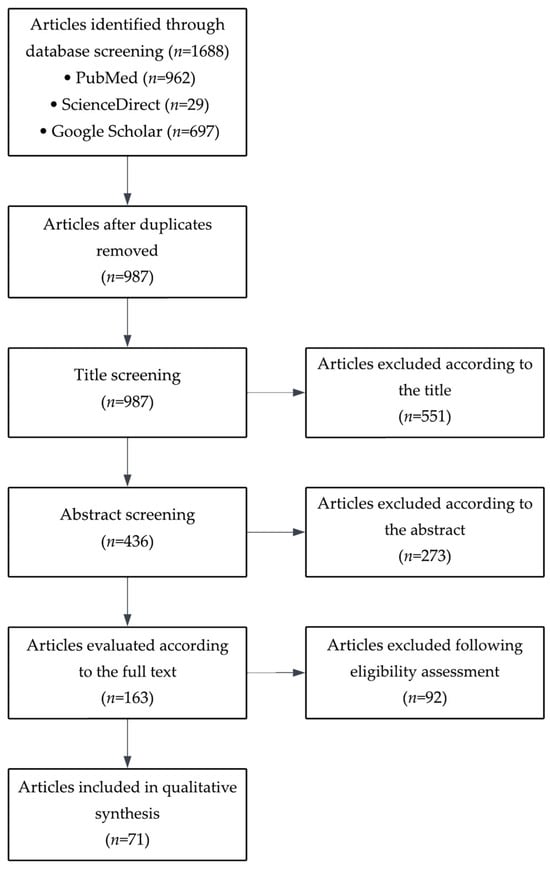
Figure 1
Open AccessArticle
Safety and Effectiveness of Dupilumab in Atopic Dermatitis Patients with Hematologic Comorbidities: A Multicenter, Retrospective Study
by
Luca Bettolini, Stefano Bighetti, Silvia Mariel Ferrucci, Angelo Valerio Marzano, Francesca Barei, Alessandra Narcisi, Matteo Bianco, Andrea Carugno, Nicola Zerbinati, Simone Ribero, Michela Ortoncelli, Elena Pezzolo, Maddalena Napolitano, Martina Maurelli, Giampiero Girolomoni, Zeno Fratton, Enzo Errichetti, Caterina Foti, Giacomo Dal Bello, Ilaria Trave, Anna Balato, Dario Didona, Niccolò Gori, Federica Veronese, Giovanni Paolino, Franco Rongioletti, Mario Bruno Guanti, Laura Calabrese, Riccardo Balestri, Manfredo Bruni and Mariateresa Rossiadd
Show full author list
remove
Hide full author list
Antibodies 2025, 14(3), 75; https://doi.org/10.3390/antib14030075 - 3 Sep 2025
Abstract
Background: Dupilumab, a monoclonal antibody targeting the interleukin-4 receptor α, is approved for moderate-to-severe atopic dermatitis (AD). However, its safety profile in patients with concomitant hematologic disorders remains unclear, as such populations were excluded from pivotal trials. Objective: To evaluate the safety and
[...] Read more.
Background: Dupilumab, a monoclonal antibody targeting the interleukin-4 receptor α, is approved for moderate-to-severe atopic dermatitis (AD). However, its safety profile in patients with concomitant hematologic disorders remains unclear, as such populations were excluded from pivotal trials. Objective: To evaluate the safety and effectiveness of dupilumab in adolescents and adults with AD and underlying hematologic comorbidities. Methods: This retrospective, multicenter study included 139 patients aged ≥15 years with moderate-to-severe AD and at least one hematologic disorder, treated with dupilumab across 21 dermatology centers. Data on disease severity, laboratory markers, and hematologic outcomes were collected over a median follow-up of 52 weeks (range 4–156). Results: The most common hematologic conditions included monoclonal gammopathies, leukemias, lymphomas, myeloproliferative neoplasms, and immune cytopenias. Clinical response to dupilumab was sustained across all endpoints, with median EASI scores decreasing from 26.0 at the baseline to 1.0 at week 52. NRS pruritus and sleep scores similarly declined to 0.0 by week 52. Serum IgE levels and eosinophil counts progressively decreased. The clinical response to dupilumab was sustained across all endpoints, with significant and progressive improvements in EASI, pruritus NRS, and sleep NRS observed up to week 52, followed by long-term stability through week 156. Serum IgE levels decreased steadily at all timepoints, while eosinophil counts declined after week 4 and stabilized beyond week 52. Hematologic conditions remained stable in 82.7% of patients, resolved in 16.5%, and progressed in only one case. Twelve patients (8.6%) received a new hematologic diagnosis during follow-up; no causal relationship could be established due to the retrospective design and absence of systematic screening, and these findings should be interpreted as descriptive associations only. Conclusions: Dupilumab appears to be safe and effective in AD patients with a broad range of hematologic comorbidities, including malignancies. These findings support its use in real-world settings, though prospective studies are warranted to further assess long-term safety in this population.
Full article
(This article belongs to the Section Antibody-Based Therapeutics)
►▼
Show Figures
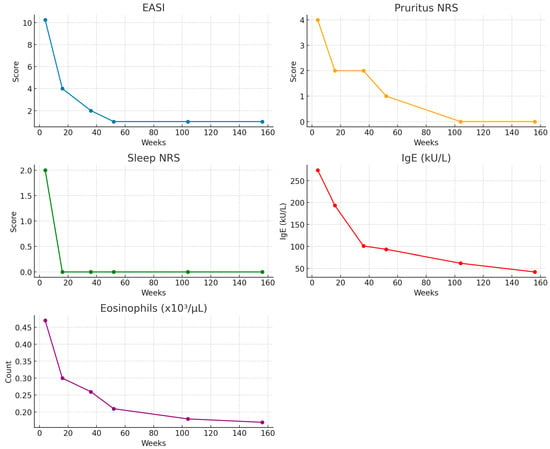
Figure 1
Open AccessArticle
Structure-Guided Stapling of Dimeric Conformations and Linker Engineering Enhance Thermostability and Fine-Tune Activity of Bispecific VHH Cytokine Agonists
by
Raphael Trenker, Deepti Rokkam, Andrew Morin, Priyanka Balasubrahmanyam, Verenice Paredes, Ivan Cheng, Rene de Waal Malefyt, Martin Oft, Patrick Lupardus and Sandro Vivona
Antibodies 2025, 14(3), 74; https://doi.org/10.3390/antib14030074 - 1 Sep 2025
Abstract
Background: Bispecific antibodies have emerged as a promising class of therapeutics, enabling simultaneous targeting of two distinct antigens. Single-domain antibodies (sdAbs) comprising camelid variable heavy chains (VHHs) provide a compact and adaptable platform for bispecific antibody design due to their small size and
[...] Read more.
Background: Bispecific antibodies have emerged as a promising class of therapeutics, enabling simultaneous targeting of two distinct antigens. Single-domain antibodies (sdAbs) comprising camelid variable heavy chains (VHHs) provide a compact and adaptable platform for bispecific antibody design due to their small size and ease of linkage. Methods: Here we investigate structure-activity relationship of VHH-based cytokine surrogates by combining cell signaling and functional assays with x-ray crystallography and other biophysical techniques. Results: We describe crystal structures of four unique bispecific VHHs that engage and activate the cytokine receptor pairs IL-18Rα/IL-18Rβ and IL-2Rβ/IL-2Rγ. These bispecific VHH molecules, referred to as surrogate cytokine agonists (SCAs), create unique cytokine signals that can be tuned by linker engineering. Our structural analysis reveals multiple dimeric conformations for these bispecific SCAs, where the two VHH domains can interact to form a compact structure. We demonstrate that the dimeric conformation can be enforced via engineering of a non-native disulfide bond between the VHH subunits, thus enhancing molecular thermostability. Conclusion: Our findings have important implications for the design and engineering of bispecific VHHs or sdAbs, offering a novel strategy for tuning their activity and increasing their stability.
Full article
(This article belongs to the Section Antibody Discovery and Engineering)
►▼
Show Figures

Graphical abstract

Journal Menu
► ▼ Journal Menu-
- Antibodies Home
- Aims & Scope
- Editorial Board
- Topical Advisory Panel
- Instructions for Authors
- Special Issues
- Topics
- Sections & Collections
- Article Processing Charge
- Indexing & Archiving
- Editor’s Choice Articles
- Most Cited & Viewed
- Journal Statistics
- Journal History
- Journal Awards
- Conferences
- Editorial Office
Journal Browser
► ▼ Journal BrowserHighly Accessed Articles
Latest Books
E-Mail Alert
News
Topics
Topic in
Cancers, CIMB, Current Oncology, Sci. Pharm., Antibodies, IJMS, IJTM
Antibody-Mediated Therapy and Other Emerging Therapies in Cancer Treatment
Topic Editors: Won Sup Lee, Yaewon Yang, Seil GoDeadline: 31 July 2026

Conferences
Special Issues
Special Issue in
Antibodies
Therapeutic Antibodies: New Trends in Discovery, Developability and Characterization
Guest Editors: Anne Zeck, David J VanceDeadline: 15 December 2025
Special Issue in
Antibodies
Antiviral Antibody Immune Responses in the Context of Vaccination and Infection
Guest Editors: Jagadeesh Bayry, Guglielmo LuccheseDeadline: 15 December 2025
Special Issue in
Antibodies
Recombinant Binding Proteins and Genetically Engineered T-cells Targeting Intracellular Neoantigens
Guest Editors: Thomas Böldicke, Ana Maria Waaga-GasserDeadline: 25 February 2026
Special Issue in
Antibodies
Selected Papers from The 1st International Online Conference by Antibodies 2025
Guest Editor: Arne SkerraDeadline: 28 February 2026
Topical Collections
Topical Collection in
Antibodies
Computational Antibody and Antigen Design
Collection Editor: Buyong Ma



